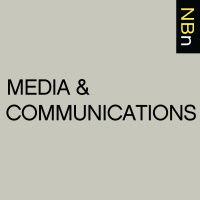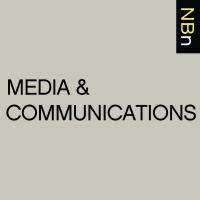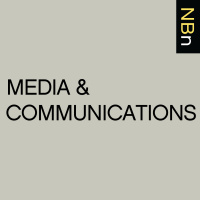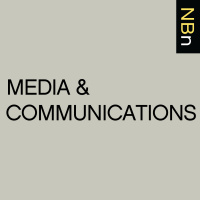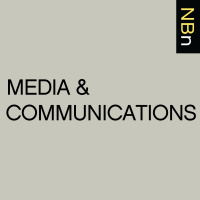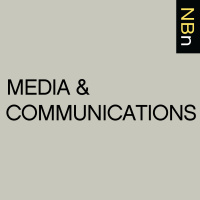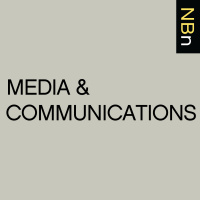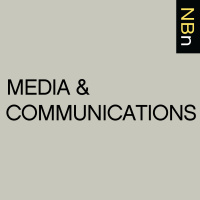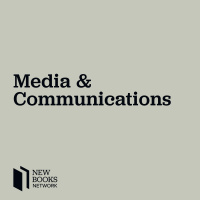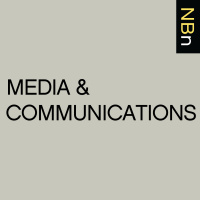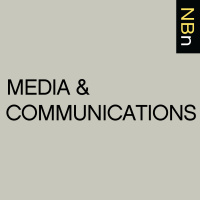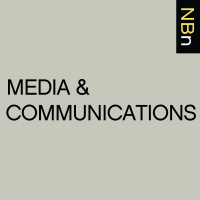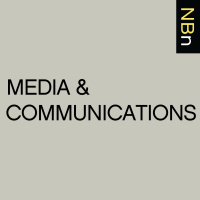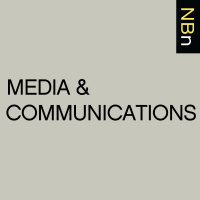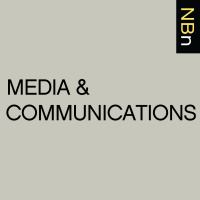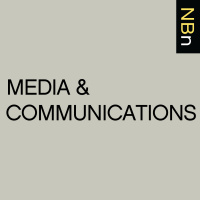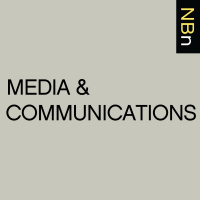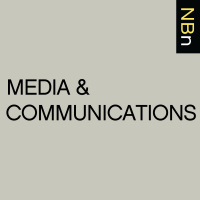Synopsis
Interviews with Scholars of Media and Communications about their New Books
Episodes
-
Johanna Drucker, “Graphesis: Visual Forms of Knowledge Production” (Harvard University Press, 2014)
11/12/2014 Duration: 01h06minJohanna Drucker‘s marvelous new book gives us a language with which to talk about visual epistemology.Graphesis: Visual Forms of Knowledge Production (Harvard University Press, 2014) simultaneously introduces the nature and function of information graphics, awakens readers to the visual interfaces prevalent in our daily work, and considers how paying careful attention to visual interpretation can serve a broader humanistic agenda. Drucker urges us to think of graphic forms of knowledge not as mere presentation, but as interpretation, as “arguments made in graphical form.” Here, images are not necessarily fixed displays of information:Drucker suggests a way to think about images as producers of knowledge. Once we understand and approach a graphic display as a generative technology, it opens up some fascinating ways of imagining the future of the book, of reading, and of composition. As a thoughtfully and beautifully produced volume, Graphesisalso challenges our visual and material expectations for a book-as-ob
-
Beth Driscoll, “The New Literary Middlebrow: Readers and Tastemaking in the Twenty-First Century” (Palgrave-MacMillan, 2014)
03/12/2014 Duration: 41minIt is a cliche to suggest we are what we read, but it is also an important insight. In The New Literary Middlebrow: Readers and Tastemaking in the Twenty First Century (Palgrave-MacMillan, 2014), Beth Driscoll, from University of Melbourne, extends and critiques the work of Pierre Bourdieu to account for modern literary tastes and the literary field in which those tastes are embedded. The book attempts to explore and defend the idea of the middlebrow in literature. ‘Middlebrow’ is defined by eight characteristics, whereby it is middle class, it has reverence to elite cultures, and it is entrepreneurial, mediated, feminized, emotional, recreational and earnest. In the main it is situated within the tension between the aesthetic and the commercial. The book uses four case studies to explore how this tension, along with the idea of the middlebrow, plays out. In the first case study the role of Oprah Winfrey as a tastemaker and cultural intermediary is explored as part of an analysis of book clubs. The analysis s
-
Victor Pickard, “America’s Battle for Media Democracy” (Cambridge UP, 2014)
25/11/2014 Duration: 30minThe media system in the United States could have developed into something very different than what it is today. In fact, there was an era in which significant media reform was considered. This was a time when media consumers were tired of constant advertising, bias, and control by corporate entities, and instead wanted more “public-oriented” content. Sound at all familiar? In his new book, America’s Battle for Media Democracy: The Triumph of Corporate Libertarianism and the Future of Media Reform (Cambridge University Press, 2014), Victor Pickard, an assistant professor of communication at the Annenberg School for Communication at the University of Pennsylvania, examines the debates on media reform and policy from the early 20th century, focusing, in particular, on radio. Pickard revisits the significant media policy conflicts to analyze why the American media is the way it is, and how it could have been. In so doing, he considers what the current American media system means for the Web and other new media.
-
Bridget Conor, “Screenwriting: Creative labor and professional practice” (Routledge, 2014)
18/11/2014 Duration: 50minBridget Conor’s new book, Screenwriting: Creative Labor and Professional Practice (Routledge, 2014), looks closely at the creative practice and profession of screenwriting for film and television in the US and UK. Situated within the critical media production studies paradigm, Screenwriting analyzes the history, current industrial practices, identities, and cultural milieu that surround this form of creative labor. Conor examines the professional myths that are often associated with screenwriting by looking back at its history during Hollywood’s golden age, beginning with the groundbreaking work of sociologist Hortense Powdermaker. Then, utilizing theoretical frameworks developed by luminaries of media production studies such as Angela McRobbie, John T. Caldwell, and David Hesmondhalgh, Conor outlines the contemporary labor scene for screenwriters. Through in-depth interviews with professional screenwriters, Conor underscores some of the commercial and creative tensions in the industry that often challenge
-
Randal Marlin, “Propaganda and the Ethics of Persuasion” (Broadview Press, 2013)
17/11/2014 Duration: 41minIt’s been 100 years since the start of the First World War, a conflict that cost millions of lives. In his recently revised book, Propaganda and the Ethics of Persuasion (2013), Randal Marlin writes that Britain pioneered propaganda techniques to sell that war that have been imitated ever since. He tells how the British spread a false story about Germans boiling the bodies of their dead soldiers in corpse factories. It was designed to paint Germany as a uncivilized, ghoulish nation that had to be fought. Marlin also tells how American propaganda during the First World War helped foster the modern public relations and advertising industries. Marlin, who studied with the French propaganda theorist Jacques Ellul, sees propaganda as a manipulative exercise of power and he argues that in order to defend ourselves against it, we need to recognize its methods and techniques. His revised second edition analyzes how the Bush administration used fear to persuade Americans to support the invasion of Iraq. The book tra
-
Eric Hayot, “The Elements of Academic Style: Writing for the Humanities” (Columbia University Press, 2014)
13/11/2014 Duration: 01h08min“This is a book that wants you to surpass and destroy it.” Eric Hayot‘s new book has the potential to transform how we teach and practice academic writing, and it invites the kind of reading and engagement that makes such a transformation possible. The Elements of Academic Style: Writing for the Humanities (Columbia University Press, 2014) is a style guide geared specifically toward academic writers in the humanities, paying special attention to the field of literary and cultural theory but applying equally well across humanistic disciplines. At turns funny, moving, and brilliant – not always qualities we associate with writing style guides – Hayot’s book treats writing as a process that encompasses “behavioral, emotional, & institutional parameters.” The first section of the book treats writing as a form of life, addressing the contexts and habits of the writer and the institutional contexts in which we teach and write. It also offers some strategies for getting writing done in the course of the typically c
-
Alon Peled, “Traversing Digital Babel: Information, E-Government, and Exchange” (MIT Press, 2014)
07/11/2014 Duration: 44minFailure by government agencies to share information has had disastrous results globally. From the inability to prevent terrorist attacks, like the 9-11 attacks in New York City, Washington D.C., and Pennsylvania, to the ill-equipped and ill-fated responses to disasters like the nuclear meltdown at Fukushima, and Hurricane Katrina, a common denominator in all of these events, and those similar, was a lack of inter- and intra-government information sharing. In his new book Traversing Digital Babel: Information, E-Government, and Exchange (MIT 2014), Alon Peled, associate professor of political science at The Hebrew University of Jerusalem, conceptualizes a platform that would incentivize inter-agency information sharing. Called the Public Sector Information Exchange (PSIE), the platform would not only enable the trading of information, but also offers the valuation of information assets. In this way the PSIE creates an inter-government economic system. In detailing of the opportunities and threats to such a sys
-
Ethan Zuckerman, “Rewire: Digital Cosmopolitans in the Age of Connection” (Norton, 2013)
06/11/2014 Duration: 48minIn the early days of the Internet, optimists saw the future as highly connected, where voices from across the globe would mingle and learn from one another as never before. However, as Ethan Zuckerman argues in Rewire: Digital Cosmopolitans in the Age of Connection (Norton, 2013), just because a connection is possible does not mean disparate voices are being heard. Instead, things and not ideas have become more connected; we now live in a world where is easier to get a bottle of water from a tropical island halfway around the world than it is to get (let alone comprehend) news from that island. Zuckerman, a media scholar and activist based at MIT, suggests despite our perceived “connectedness,” the wired world is actually becoming more provincial and narrow, as we shift from professionally curated news and information, to search engines and algorithmically selected information based on previous “likes” and those of our homogeneous social circles. In other words, we are getting more and more of what we alread
-
Marisol Sandoval, “From Corporate to Social Media” (Routledge, 2014)
05/11/2014 Duration: 39minWhat would a truly ‘social’ social media look like? This is the core question of From Corporate to Social Media: Critical Perspectives on Corporate Social Responsibility in Media and Communication Industries (Routledge, 2014), the new book by Marisol Sandoval. The text is concerned with the emergence of a seemingly open and democratic space, social media, which is in fact subject to corporate dominance and control. The book aims to provide a political economy of the social relations in which media and communications industries are embedded, to reveal the inequalities of both power and control in social media. This point is illustrated through case studies of major corporations. Sandoval takes an important theme- including net neutrality, e-waste, ideologies, and labour conditions- and compares and contrasts CSR statements and positions with the reality of corporate actions on these themes. Case studies include Google, Apple, Disney and AT&T. The book concludes by considering how social media might become more
-
Hugh F. Cline, “Information Communication Technology and Social Transformation” (Routledge, 2014)
09/10/2014 Duration: 42minThere is no doubt that innovations in technology have had, and are having, a significant impact on society, changing the way we live, work, and play. But the changes that we are seeing are far from novel. In fact, most are a continuation of changes to society and societal structure with roots in the past. So argues Hugh F. Cline, adjunct professor of sociology and education at Teachers College, Columbia University, in his new book, Information Communication Technology and Social Transformation: A Social and Historical Perspective (Routledge, 2014). According to Cline, the technopanics, or strong objections to new technology have happened since the days of Aristotle. In spite of the objections, technological innovations can positively advance societal interests. Mixing history, sociology, anthropology, and technological studies, Cline provides context for the examination of how ICTs are impacting society. Learn more about your ad choices. Visit megaphone.fm/adchoices
-
Brooke Erin Duffy, "Remake, Remodel: Women's Magazines in the Digital Age" (U Illinois Press, 2013)
18/09/2014 Duration: 35minBrooke Erin Duffy's Remake, Remodel: Women's Magazines in the Digital Age (University of Illinois Press, 2013) traces the upheaval in the women's magazine industry in an era of media convergence and audience media-making. Duffy, assistant professor at Temple University's School of Media and Communication, is especially interested in the experience of writers, editors, and others who produce women's magazines: How are they coping with new competition, more intense work routines, and the imperative to produce (and engage) across a range of non-print media platforms? Questions of identity thread through the book: What does it mean to be a magazine writer in the iPad era? What are the stakes for gender identity as this female-focused genre adapts to digital workflows? To get at these questions, Duffy conducted in-depth interviews with dozens of editors, publishers, interns, and business-side workers, most of them at the big three magazine publishers, Hearst, Conde Nast, and Time, Inc. Remake, Remodel traces the h
-
Julia Azari, “People’s Message: The Changing Politics of the Presidential Mandate” (Cornell UP, 2014)
08/09/2014 Duration: 33minJulia Azari has written Delivering the People’s Message: The Changing Politics of the Presidential Mandate (Cornell University Press, 2014). Azari is assistant professor of political science at Marquette University. What was President Obama’s mandate when he was elected in 2008? Did that mandate extend to 2012? We commonly think that mandates attach to wide electoral margins. Azari cuts through this convention to analyze the variety of ways presidents have used the language of mandates to advocate for their policy agenda. Azari’s book fits with a book featured on the podcast in May by John Hudak. Both books link together the political and policy dimensions of the presidency. Azari discovers that presidents refer to mandates when political polarization increases and as the White House loses legitimacy. By the time President Obama was elected, these factors came together, thereby increasing the use of mandate language and the unrealistic expectations that often come with lofty promises. Learn more about your a
-
Jeremy Lipschultz, “Social Media Communication: Concepts, Practices, Data, Law, and Ethics” (Routledge, 2014)
07/09/2014 Duration: 45minSocial media is a phenomenon that continues to grow and attract much attention in the form of consternation, commentary, criticism and scholarly research. Any attempt at truly understanding social media communication practices and tools requires interdisciplinary analysis, the examination of the technology from the varying perspectives of the groups of users, developers and experts with respect to the issues surrounding it. It also should include a look at the changes social media has and continues to bring to various fields, particularly with respect to professional communication. Jeremy Lipschultz, Isaacson Professor in the School of Communication at the University of Nebraska at Omaha, discusses the impact of social media on various mass communications professions in his new book Social Media Communication: Concepts, Practices, Data, Law, and Ethics (Routledge 2014). In his book, Lipschultz examines the various theories and practices connected to social media communication, and how this emerging form of c
-
Joe Moran, “Armchair Nation: An Intimate History of Britain in Front of the TV” (Profile Books, 2013)
30/07/2014 Duration: 49minThe social and cultural historian Joe Moran, Professor of English and Cultural History at Liverpool John Moores University, UK is interested in the everyday moments between great events. In his books Queuing for Beginners: The Story of Daily Life from Breakfast to Bedtime, On Roads: A Hidden History and now Armchair Nation: An Intimate History of Britain in Front of the TV (Profile Books, 2013) he documents the mundane activities that make up our lives. In Armchair Nation Moran surveys the history of television watching in Britain from the technology’s first demonstration in a department store in 1925 and up to today. Moran’s engaging narrative progresses through major milestones in the medium’s history. To document how watching television had become a daily habit for a multitude of individuals, Moran uses an assortment of sources such as newspaper reviews, listings and interviews, diaries, and Mass Observation entries. While Moran hesitates to treat the consumption of television as an act of community build
-
Judith Donath, “The Social Machine: Designs for Living Online” (MIT Press, 2014)
19/07/2014 Duration: 31minThe conversation about the Web and social media skews toward a discussion of the potential for connections, and how both individuals and organizations are using the media to communicate, to form communities, and to conduct business. Lacking, for the most part, is an investigation of the design of these spaces and how design, both good and bad, encourages or provokes certain kinds of interactions. In her new book, The Social Machine: Designs for Living Online (MIT Press, 2014), Judith Donath, Faculty Fellow at Harvard University’s Berkman Center, explores the theory and practice of interface design, and analyzes how design influences online interaction. With a view toward inspiring designers, and others, “to be more radical and thoughtful in their creations,” Donath provides a detailed examination of topics to be considered for beneficial design. Learn more about your ad choices. Visit megaphone.fm/adchoices
-
Lisa Gitelman, “Paper Knowledge: Toward a Media History of Documents” (Duke UP, 2014)
09/07/2014 Duration: 01h06min“One doesn’t so much read a death certificate, it would seem, as perform calisthenics on one…” From the first, prefatory page of Lisa Gitelman‘s new book, the reader is introduced to a way of thinking about documents as tools for creating bodily experience, and as material objects situated within hierarchies and relationships of labor. Working beautifully at the intersection of media studies and history, Paper Knowledge: Toward a Media History of Documents (Duke University Press, 2014) curates a thoughtful and inspiring collection of moments from the expansion of a modern “scriptural economy.” The case studies explore fill-in-the-blank forms in the context of late nineteenth century job printing, typescript books and scholarly communication in the 1930s, photocopies and photocopying in the 1960s and 1970s, and PDF files in the 1990s and beyond. The final chapter is a fascinating exploration of what it might look like to write a situated history of amateurdom and the figure of the “amateur,” a theme that re
-
Payal Arora, “The Leisure Commons: A Spatial History of Web 2.0” (Routledge, 2014)
02/07/2014 Duration: 33minScholars and commentators have used metaphor in an attempt to describe the Web since public access began. Think of ideas like the information highway, cyberspace, the digital library, etc. In her new book, The Leisure Commons: A Spatial History of Web 2.0 (Routledge, 2014), Payal Arora, an assistant professor in the Department of Media and Communication at Erasmus University Rotterdam, takes a novel approach to the use of metaphor by examining the parallels between public common spaces and Web 2.0. In the book, Arora uses an interdisciplinary approach to exploring the historical, geographical, political and social issues related to public parks. In so doing, Arora, provides a foundation for how policymakers, organizations and individuals may conceptualizes the debates surrounding common spaces, particularly Web 2.0. Learn more about your ad choices. Visit megaphone.fm/adchoices
-
Ian Haney Lopez, “Dog Whistle Politics: How Coded Racial Appeals Have Reinvented Racism and Wrecked the Middle Class” (Oxford UP, 2014)
30/06/2014 Duration: 23minIan Haney Lopez is the author of Dog Whistle Politics: How Coded Racial Appeals Have Reinvented Racism and Wrecked the Middle Class (Oxford UP 2014). He is the John H. Boalt Professor of Law at the University of California, Berkeley, and on the Executive Committee of the Thelton E. Henderson Center for Social Justice. Lopez investigates the often hidden side of racism. He traces the political history of candidates for office using a set of coded phrases, allusions, and references to call attention to race, without ever uttering the word. In the post Brown v. Board era, Lopez argues, candidates learned a new language of strategic racism, substituting anti-government rhetoric for anti-black, anti-Latino, or anti-immigrant. In doing so, the dog whistle was heard as a much wider criticism of the social welfare state, and thus a direct attack not just on minorities, but on the middle class. Learn more about your ad choices. Visit megaphone.fm/adchoices
-
Patrick Burkart, “Pirate Politics: The New Information Policy Contests” (MIT Press, 2014)
26/06/2014 Duration: 42minThe mid-’00s saw the rise of a political movement in Europe concerned with technocratic impositions on the ideals of free culture, privacy, government transparency and other technology policy issues. Led by online file sharers and developers, the Swedish Pirate Party was thrust into the spotlight in 2006 after law enforcement shut down the popular file sharing site The Pirate Bay. In his new book, Pirate Politics: The New Information Policy Contests (MIT Press, 2014), Patrick Burkart, an associate professor of communication at Texas A&M University and currently a visiting scholar at the University of Helsinki, examines the rise of the Pirate Party in Sweden, and later Germany. To do so, Burkart analyzes ideas about the colonization of Internet communities and resources using critical communications theories. In do doing, Burkart provides a foundation for the examination of the spread of Pirate parties across the globe as well as the rise of similarly aligned political movements. Learn more about your ad choic
-
John Nathan Anderson, “Radio’s Digital Dilemma: Broadcasting in the 21st Century” (Routledge, 2014)
20/06/2014 Duration: 52minJohn Nathan Anderson’s new book, Radio’s Digital Dilemma: Broadcasting in the 21st Century (Routledge, 2014), documents the somewhat tortured path of broadcast radio’s digital transition in the United States. Beginning his analysis with rise of neoliberal communications policy in the 1980s, Anderson charts the development of the idea of digitalization by closely examining two key archival sources: The Federal Communication Commission’s extensive archive of rulemaking and public comments and the archives of the two most important trade journals in broadcast radio, Radio World and Current. As Anderson explores in the book, FCC regulatory neglect coupled with the huge consolidation within the radio industry following the passage of the Telecommunications Act of 1996 resulted in a digital transition that was dictated largely by commercial interests. For example, the most important decision about digital radio – the engineering standard for digital broadcasting – was determined by a federation of corporations t

